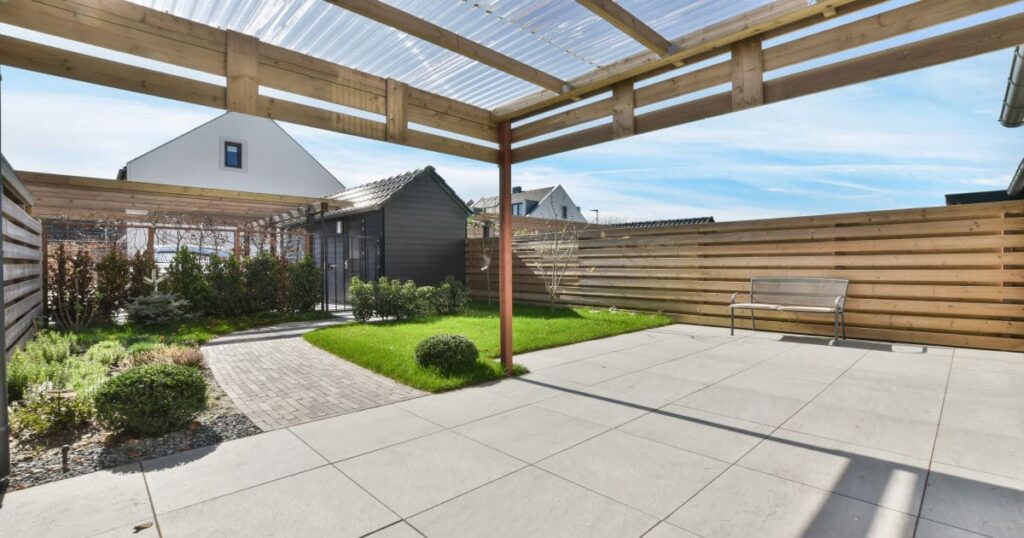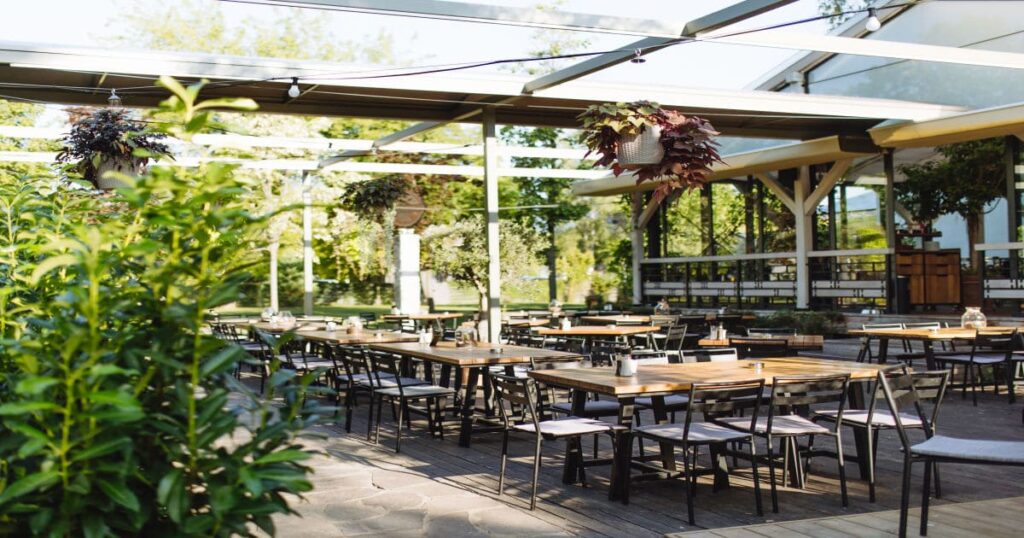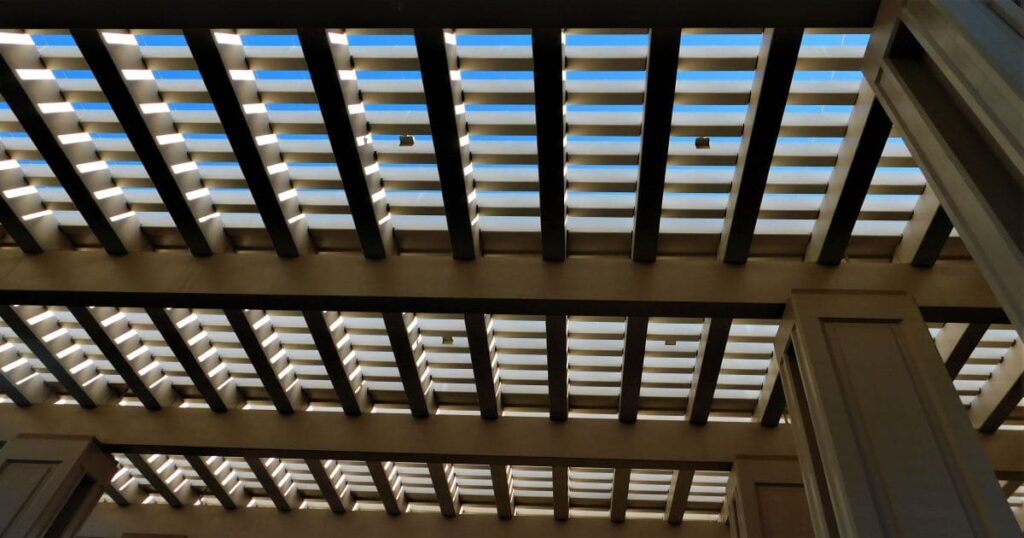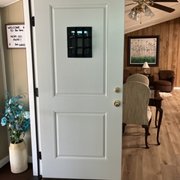Imagine a regular backyard, where you can’t do much when the weather’s bad. Now, think about putting up a patio cover in just the right spot. It changes the whole backyard into a cozy outdoor spot that you can use anytime, no matter how sunny or rainy it is.
Adding a patio cover to your outdoor area makes it better in many ways. It gives you shelter from the weather, makes the space look nicer, and adds more room to hang out, whether your style is classic or contemporary.
The Basics of Patio Covers
Patio covers are structures that give shade and protection to outdoor areas. They can be attached to your house or stand alone. They come in different styles and sizes, and they’re useful for both keeping you comfortable and making your place look nice.
Materials Commonly Used
Common materials used for patio covers include wood, metal, and fabric. Wood is usually chosen for its natural aesthetic but it needs regular maintenance. Metal choices, like aluminum, last a long time and don’t need much upkeep. Fabric options, like canvas, can bend and change, but they might not last as long.
Benefits of Patio Covers
- Weather Protection
Putting up a patio cover is great for keeping you comfy no matter what the weather’s like. It blocks out the sun, keeps you dry when it rains, and helps you stay cozy when it’s windy. So, you can enjoy your outdoor space all year round.
- Extended Living Space
Adding a patio cover makes your outdoor space more useful. It protects you and makes it comfy, turning your patio into an extra room where you can eat, chill, or have friends over.
- Aesthetic Appeal
Patio covers not only make your outdoor area better but also make it look nicer. You can get them to match how your house and yard look, making them a cool centerpiece.

Types of Patio Covers
Pergolas
Pergolas are patio covers made of wood or metal with a roof that lets some sunlight through. They’re common in big outdoor areas like gardens, where they look nice and you can hang stuff on them like plants or lights.
Awnings
Awnings are like big umbrellas attached to your house, shading your patio. They can be fabric or metal, and some can roll in and out depending on the weather.
Gazebos
Gazebos are freestanding, often octagonal or round, structures with a solid roof and open or semi-open sides. They provide full shade and can be equipped with additional features like screens or curtains for added privacy and bug protection. Gazebos are versatile, fitting well into both formal and casual landscape styles.
Shade Sails
Shade sails are sleek patio covers made of stretchy fabric, tied to poles or buildings. They look cool and modern, perfect for trendy outdoor designs. They’re not super strong, but you can make them any shape or size you want.
Landscape Styles and Patio Covers
Traditional Landscapes
In classic gardens, patio covers blend in with the house, using the same materials and colors. You might see wooden pergolas that match the house’s colors or gazebos with similar design touches. They might have fancy patterns or even lights to keep that classic feel.
Adding a patio cover to a classic garden isn’t just useful—it also makes everything look good together and never goes out of style. A nice patio cover can even be the main focus of the outdoor area, where you can put other classic stuff like flowers, stone paths, or water features around it.
Modern Landscapes
In modern gardens, everything’s about simple, clean looks and practicality. Patio covers like roll-in awnings or metal pergolas with smooth shapes are perfect for this. They’re often made of tough stuff like aluminum or stainless steel, and fabrics for awnings are usually neutral colors to keep things simple.
Modern patio covers can also add technology for more convenience and functionality. For instance, retractable awnings might come with remote controls or sensors that detect weather conditions, automatically opening and closing based on the situation.
Adding a patio cover to a modern garden isn’t just for shade—it’s a style choice too. Its sleek lines and fancy features go well with other modern stuff outside, like square planters, flexible furniture, and cool lights.
Tropical Landscapes
In tropical gardens, it’s all about making a lush, exotic vibe with lots of colorful plants, water stuff, and bright decorations. Patio covers here might look like those you’d find on a tropical island or by the beach, with bamboo or thatched roofs, or colorful fabric shades that match the plants around them.
Patio covers in tropical gardens don’t just give shade—they’re perfect for hanging plants, making it feel like a jungle. They can match other stuff in the garden, like bamboo torches, wicker furniture, or stone paths, to complete the tropical look.
The patio cover isn’t just for shade—it’s like a piece of the tropical paradise, making your outdoor space feel like a secret getaway. It brings everything in the garden together, making it look and feel like a tropical dream.
Desert Landscapes
In desert gardens, the focus is on tough plants, gravel or stone floors, and colors that match the surroundings. Patio covers here are all about giving shade from the hot sun while looking like they belong in the rugged desert. They’re usually made of strong stuff like metal or special wood that can handle the tough weather.
In desert gardens, patio covers can blend in with the surroundings. For instance, a pergola might use old wood or worn metal to match the rustic look. Or, you could go for a shade sail in earthy colors to keep things shaded without standing out too much.
In desert gardens, the patio cover isn’t just something extra—it’s an actual part of the design. It gives shade and helps everything look like it belongs together outside.
Cottagecore Landscapes
In cozy cottage gardens, patio covers are like charming hideaways that add to the fairy-tale vibe. You might see wooden pergolas covered in climbing flowers like roses or wisteria, making the garden feel even more romantic and old-fashioned.
For a cottage-style garden, you can use patio covers with flowery or checkered patterns to match the theme. Even awnings or shade sails can work, especially if they look handcrafted or vintage.
The patio cover in a cottagecore landscape is more than just a practical structure; it’s very important in creating a setting that feels both nostalgic and idyllic. Whether serving as a backdrop for afternoon tea or as a reading nook surrounded by the sounds and sights of nature, the patio cover becomes a living part of the landscape’s fairytale charm.

Design Tips for Integrating Patio Covers
Material Matching
When adding a patio cover, go for something that matches what’s already there to make everything look like it belongs together outside. For instance, if your deck is made of redwood, try adding a redwood pergola to create a seamless transition. If you have a lot of metal accents like outdoor light fixtures or furniture, an aluminum or steel patio cover could be a fitting addition.
Plant Selection
The plants around your patio cover can change how it looks and works. In tropical or cottagecore landscapes, think about adding climbing plants like wisteria, roses, or honeysuckle to create a living canopy. For desert landscapes, place potted cacti or succulents around a metal pergola to reflect the natural environment. Consider how the plants will affect your patio cover. Some might give more shade, while others are just for looks.
Color Coordination
Make sure the color of your patio cover matches the colors outside and on your house so everything looks like it belongs together. Neutral colors like white, beige, or gray often work well in modern landscapes, while more vibrant or natural tones can be more fitting for tropical or traditional settings.
Keep in mind that the color you pick will mix with the natural light and might change how the area feels. For example, a darker color might make the space feel smaller but cozier, while a lighter shade could add a more airy and open feel.
Costs and Budgeting
Cost Factors
Adding a patio cover to your yard can be a bit complicated when it comes to money. Materials are usually the biggest expense, especially if you go for fancy stuff like aluminum or top-notch wood. Labor costs can also be high, especially for more complex designs or if the patio cover needs to be custom-built. Additional factors like the size of the patio cover, any specialized technology or features, and even local building permits can also influence the overall cost.
Budgeting Tips
To make sure you don’t overspend but still get the patio cover you want, planning is super important. Here are some helpful tips:
Prioritize Needs Over Wants: Make a list of must-haves and nice-to-haves. If all you need is shade from the sun, maybe just go for a simple shade sail instead of a fancier pergola.
Get Multiple Quotes: Get quotes from a few different contractors to see how much your project might cost. This can also help you bargain for a better price.
Phase the Project: If you’re worried about money, you could split the project over time. Begin with the basics and add more stuff later when you have the cash.

Maintenance and Upkeep
Cleaning Tips
Regularly clean your patio cover to maintain its appearance and integrity. For wood structures, a simple soap-and-water mixture is usually enough for surface cleaning. For metal or vinyl, specialized cleaners are available that remove dirt and grime without affecting the material’s finish. Always test a small area first to ensure the cleaner matches your patio cover material.
Seasonal Care
Each season brings its own set of challenges for patio cover maintenance:
Spring: This is the time for thorough inspections. Check for any winter damage and make necessary repairs. It’s also a good time to reseal or repaint wooden structures.
Summer: High temperatures and intense sunlight can cause materials to fade or warp. Use protective sealants for wood and keep metal structures clean to prevent heat-related deterioration.
Autumn: Clear away leaves and other debris from the roof and gutters of your patio cover to prevent water pooling and eventual rot or corrosion.
Winter: If you live in a snow-prone area, remove heavy snow from the top of your patio cover to prevent structural damage.
Longevity and Replacement
The lifespan of a patio cover largely depends on the material used and how well it’s maintained. If well cared for, wood structures can last over 15 years. Metal and vinyl covers can last even longer with proper upkeep. Signs that replacement is needed could include persistent leaks, visible rot, or severe warping.
A Canopy of Possibilities
Patio covers do more than just serve a purpose; they completely change how different gardens look, whether it’s the rugged charm of deserts, the cozy feel of cottage-style gardens, or the simple beauty of modern spaces. By picking materials, plants, and colors carefully, you can blend these structures perfectly with your outdoor setup, so they feel like they belong as much as the plants and furniture. So, don’t hold back—unleash your creativity, experiment with designs, and make that patio cover uniquely yours. After all, the sky—or perhaps, the cover—is the limit.

Frequently Asked Questions
Can I Install a Patio Cover Without a Permit?
Permit requirements depend on location and the type of structure you’re installing. It’s advisable to check with your local municipality or homeowners association for specific guidelines.
How Do I Choose the Right Size for My Patio Cover?
The size of your patio cover should align with the available space and your specific needs. Too large could overwhelm your yard, while too small may not provide adequate protection or functionality.
How Do I Protect My Patio Cover From Pests?
Using treated wood can deter termites, while regular cleaning can prevent bird or wasp nests. Some people also use natural or chemical repellents to keep pests at bay.
Can a Patio Cover be Attached to the House?
Yes, many patio covers are designed to be attached to an existing structure. However, this often requires more careful planning and possibly a building permit, as it involves altering your home.
Is it Possible to Install Lighting and Fans on My Patio Cover?
A: Yes, many patio covers can accommodate electrical fixtures like lighting and fans, although this will likely require professional installation to ensure safety and compliance with electrical codes.
What’s the Best Way to Decorate My Patio Cover for Seasonal Events?
Temporary decorations like string lights, fabric drapes, or themed ornaments can add a festive touch. Just make sure any additions are securely fastened and suitable for outdoor conditions.



























